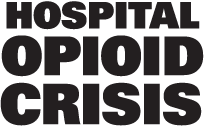
FAQ
Why have hospitals gotten involved in lawsuits against opioid distributors and manufacturers?
Hospitals are suing opioid distributors and manufacturers because of their role in deceiving the medical community and patients about the addictive nature of opioid drugs. That deception was the foundation of the opioid epidemic and has resulted in massive amounts of unreimbursed medical care provided directly to addicted patients by America’s hospitals.
How much are the hospitals seeking?
The lawsuits may vary, but hospitals are asking judges and juries to determine awards based on the financial and operational harm experienced by hospitals in each state in which lawsuits have been filed.
Why do hospitals deserve part of the settlement money?
Besides patients themselves, hospitals are among those most directly impacted by the opioid crisis. Hospitals serve as the treatment option of both first and last resort for many opioid-addicted patients, from babies afflicted with neonatal abstinence syndrome (NAS) from opioid exposure in the womb to long-term addicts whose opioid use has led to organ failure and widespread infection.
For perspective, the average cost to treat an overdose patient requiring a stay in an intensive care unit was $92,408 in 2015. The cost to treat NAS nationwide ballooned from $91 million in 2004 to $563 million in 2014. Frequently, opioid-addicted patients have no insurance or are covered by Medicaid, which does not fully cover the cost of care.
Additionally, hospitals are in the best position to address the problem:
- They have brick and mortar structures that can serve as a place to begin treatment
- They have the medical professionals needed to manage the issue
- Many addicted patients are already accessing hospital emergency rooms, sometimes on a frequent basis (but only for acute and episodic care)
America’s hospitals can lead us out of this crisis – but they must be active participants in settlement discussions with opioid manufacturers and distributors.
Are hospitals suggesting that opioid settlement funds go to hospitals instead of to states or municipalities?
No. The harm caused to state and local governments cannot be overlooked, but no one will win unless the claims of America’s hospitals are given significant attention. Twenty-one years of experience with the Big Tobacco settlement have shown us that funds rarely “trickle down” to hospitals and other frontline caregivers; in fact, shockingly few dollars went to the intended purpose of smoking cessation and education. Our nation has a chance to do better this time if opioid settlement funds become available to governments and hospitals.
Aren’t hospitals and doctors at least partially to blame for the crisis?
The health care community depends on drug makers and their distributors to accurately and honestly present their products to physicians and pharmacists. Drug makers employ scientists and researchers to develop, test and validate their products to ensure they deliver the therapeutic benefits claimed in their marketing materials. They also employ armies of marketers.
In the mid to late 1990s, pharmaceutical companies sought to increase revenues and market share by broadening use of opioid pain relievers. To expand that base and increase the rate at which prescribers turned to opioids, drug companies falsely reassured the medical community that opioid use among new patient populations was not only safe and effective, but desirable from a patient satisfaction perspective.
But wasn’t it doctors who were prescribing the medications and hospital pharmacies that were filling the orders?
The use of prescription pain medication during inpatient care – particularly for surgeries, major injuries, serious illness, etc. – and immediately following discharge has always been an appropriate standard of care. But even as hospitals have implemented opioid stewardship programs and reduced the number of opioids being prescribed, the crisis has continued to escalate. Many patients who first became addicted to prescription opioids have later turned to even more dangerous street drugs such as heroine and illegal fentanyl.
Few acute care hospitals are currently equipped to provide high-level addiction treatment services. How would that change if they receive settlement funds?
The more than 5,000 community hospitals across the nation have been on the front line of this battle for more than two decades – most often with little or no reimbursement for the care they have provided and the related costs they have incurred. No party is better positioned – given the financial resources necessary – to lead us out of this public health crisis.
Many hospitals have already developed clinical programs to treat the diseases and conditions associated with long-term opioid use. Those services are becoming increasingly necessary – in hospitals of all sizes. Hospitals are committed to treating these patients but require considerable additional funding to build out the services, staffing and protocols necessary.
If the hospital suits are successful, how will settlement funds be distributed and monitored?
Legal trusts established by the courts as part of settlement agreements or court rulings
against the opioid makers and distributors will be charged with distributing funds. Allocations will likely consider factors such as hospital size, services, volumes, harms already incurred and abatement protocols and programs already in place or under possible development.
Can hospitals still join the opioid lawsuits?
Yes – even if a case has already been filed in your state, additional hospitals are still able to join. Get involved here.
Who is behind HospitalOpioidCrisis.com and what is their goal?
HospitalOpioidCrisis.com was created by a group of law firms representing hundreds of hospitals in state and federal lawsuits against opioid manufacturers, distributors and retailers nationwide. The lawyers’ goal is to ensure that funds recovered from companies responsible for the opioid crisis are used to help hospitals provide care to patients with opioid use disorder.
